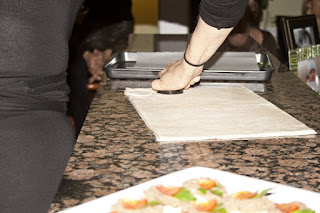Lentil Walnut Pate on Puffed Pastry
Ingredients:
Puffed pastry dough (look for it in the freezer section)
Lentil Walnut Pate (made by Beverly, but you can use any
topping)Cherry TomatoesParsley
Preheat the oven to 350 degrees. Spray a cookie sheet and
line with parchment paper. Unroll the slightly thawed puffed pastry dough.
Using a cookie cutter (she used the lid of a spice jar), cut the dough into
round pieces about the size of a large cracker. Put the round pieces on the
cookie sheet. Spray a second piece of parchment paper and put it on top of the
pastry circles and then put another cookie sheet on top of the second piece of
parchment paper, sandwiching the dough between two cookie sheets. The weight of
the second cookie sheet prevents the puffed pastry from puffing too high. Bake
for 10-15 minutes (8 minutes if you are using a convection oven) until slightly
golden. Allow to cool and then top with pate and quartered cherry tomatoes.
Kalamata Olive Pinwheels
Kalamata Olive Spread (made by Beverly, or use another
filling that doesn’t use mayonnaise) Puffed pastry dough
Unroll the slightly thawed pastry dough and trim about a
strip of dough about an inch wide from the sheet. Spread the kalamata olive
spread in a thin layer on the dough. Roll the dough back into a log and wrap it
with the parchment paper it was packaged in, and place it in the freezer for a
couple of hours (you can also make this up to a month in advance and keep it in
the freezer; let it rest for an hour on the counter until it is soft enough to
slice). When you are ready to cook the pinwheels, preheat the oven at 350
degrees. Spray a cookie sheet with not stick spray and line with parchment
paper. Cut ¼ of an inch slices and put the slices on the cookie sheet, making
up to 20 per log. Bake the pinwheels for 10 minutes or until slightly golden.
Serve warm.
Tofu Lettuce Wraps
Bibb lettuce (leaves about the size of your palm are perfect
for individually-sized wraps)Extra firm tofu roasted in hoisin sauce (coat tofu in hoisin
and toast in oven at 350 degrees for 30-40 minutes)Cooked rice noodles, choppedCarmelized onions (onions sautéed to a darker complexion)Fresh red peppers, choppedFlat leaf parsley or cilantro
Combine the tofu, rice noodles, onions, red peppers, and
parsley into a bowl. Fill the lettuce leaf with a couple of tablespoons of
filling and plate on a large, flat platter so that the wraps can lie side by
side. Serve with a vinaigrette, soy sauce, or hoisin sauce.








































